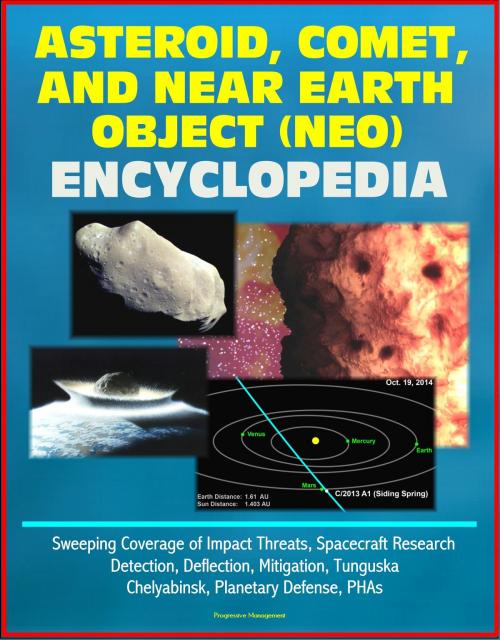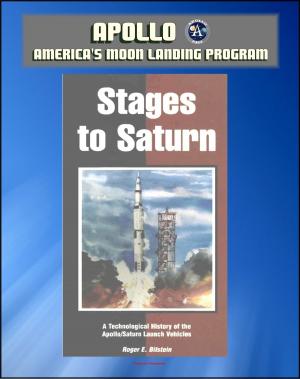Asteroid, Comet, and Near Earth Object (NEO) Encyclopedia: Sweeping Coverage of Impact Threats, Spacecraft Research, Detection, Deflection, Mitigation, Tunguska, Chelyabinsk, Planetary Defense, PHAs
Nonfiction, Science & Nature, Technology, Aeronautics & Astronautics, Science, Physics, Astrophysics & Space Science| Author: | Progressive Management | ISBN: | 9781301853076 |
| Publisher: | Progressive Management | Publication: | March 21, 2013 |
| Imprint: | Smashwords Edition | Language: | English |
| Author: | Progressive Management |
| ISBN: | 9781301853076 |
| Publisher: | Progressive Management |
| Publication: | March 21, 2013 |
| Imprint: | Smashwords Edition |
| Language: | English |
Discover all aspects of asteroids, comets, near earth objects (NEOs), and their impact threat to Earth in this massive, authoritative compilation of up-to-date official documents from NASA and other federal sources, with details about current tracking, detection, and survey efforts, spacecraft inspections of asteroids and comets, concepts for deflection of hazardous objects, and much more. There is coverage of the events of February 15, 2013, which were a stark reminder of the threat posed by space objects impacting Earth. The predicted close approach of a small asteroid, called 2012 DA14, and the unpredicted entry and explosion of a very small asteroid about 15 miles above Russia, have focused attention on the necessity of tracking asteroids and other NEOs and protecting our planet from them.
Contents include: 1. House and Senate Hearings on Asteroid and Space Threats, March 2013 * 2. Basic Overview * 3. Asteroids * 4. Comets * 5. Tunguska, Planetary Defense * 6. NASA Report: Near-Earth Object Survey and Deflection Analysis of Alternatives (2007) * 7. NASA Report: Near-Earth Object Survey and Deflection Study (2006) * 8. Potentially Hazardous Asteroid Workshop Findings (2012) * 9. Near-Earth Object Science Definition Team * 10. Natural Impact Hazard (Asteroid Strike) Interagency Deliberate Planning Exercise After Action Report, December 2008 * 11. Dawn and Vesta * 12. Deep Impact * 13. OSIRIS-Rex * 14. Stardust * 15. Impact Threats
Some of the specific topics covered include: the Congressional mandate to catalog NEOs; risk assessment and characterization; Goldstone and Arecibo radar; NEOO program; Air Force SST and Pan-STARRS; ATLAS telescope program in Hawaii; B612 Sentinel observatory; PHAs and PHOs; detection and mitigation efforts; Obama administration policies and budgets; USAF tracking; history of NEOs and life on Earth; predicted close approach of the Siding Spring comet to Mars in late 2014; latest assessment of the risk of 99942 Apophis; Toutatis; workshop findings on 2011 AG5; Hayabusa; orbit of Hermes; differences between an asteroid, comet, meteoroid, meteor and meteorite; Atiras, Atens, Apollos and Amors; Planetary Defense Conference, April 2009; major reports on deflection ideas, including nuclear subsurface, nuclear surface, nuclear standoff, kinetic impact, space tug, gravity tractor; and more.
The larger NEOs (those with a maximum physical dimension of more than a meter) are generally referred to as either asteroids or comets, while smaller objects are referred to as meteoroids. Large or small, they are all called meteors upon fiery transit of Earth's atmosphere. When pieces of a meteor survive transit through the atmosphere to strike the surface of the Earth, they are called meteorites. (Only the largest asteroids — those few with diameters in the range of hundreds of kilometers — are spherical. Smaller ones are of irregular shape.) Every day, a continual influx of these objects strikes Earth's atmosphere. Most of them are dust-sized particles, but they add up; it's been estimated that on a typical day, these particles total from 50 to 150 tons of matter. Asteroids of the order of a few meters in size strike the atmosphere roughly annually. Damage on Earth's surface is likely only when the kinetic energy of the object - the energy it carries by virtue of its mass and velocity when it enters the atmosphere - is in the range of a few hundred kilotons of TNT equivalent or above. (By comparison, the Hiroshima atomic bomb was roughly 13 kilotons of TNT equivalent.) Asteroids with this much energy are thought to strike the Earth only every 100 years or so. The more frequent, less energetic ones generally deposit that energy high enough in the atmosphere that no effects are felt at Earth's surface. The 1908 explosion over Tunguska in Siberia, which leveled trees over an area of more than 2,200 square kilometers (850 square miles), is thought to have been caused by a stony asteroid.
Discover all aspects of asteroids, comets, near earth objects (NEOs), and their impact threat to Earth in this massive, authoritative compilation of up-to-date official documents from NASA and other federal sources, with details about current tracking, detection, and survey efforts, spacecraft inspections of asteroids and comets, concepts for deflection of hazardous objects, and much more. There is coverage of the events of February 15, 2013, which were a stark reminder of the threat posed by space objects impacting Earth. The predicted close approach of a small asteroid, called 2012 DA14, and the unpredicted entry and explosion of a very small asteroid about 15 miles above Russia, have focused attention on the necessity of tracking asteroids and other NEOs and protecting our planet from them.
Contents include: 1. House and Senate Hearings on Asteroid and Space Threats, March 2013 * 2. Basic Overview * 3. Asteroids * 4. Comets * 5. Tunguska, Planetary Defense * 6. NASA Report: Near-Earth Object Survey and Deflection Analysis of Alternatives (2007) * 7. NASA Report: Near-Earth Object Survey and Deflection Study (2006) * 8. Potentially Hazardous Asteroid Workshop Findings (2012) * 9. Near-Earth Object Science Definition Team * 10. Natural Impact Hazard (Asteroid Strike) Interagency Deliberate Planning Exercise After Action Report, December 2008 * 11. Dawn and Vesta * 12. Deep Impact * 13. OSIRIS-Rex * 14. Stardust * 15. Impact Threats
Some of the specific topics covered include: the Congressional mandate to catalog NEOs; risk assessment and characterization; Goldstone and Arecibo radar; NEOO program; Air Force SST and Pan-STARRS; ATLAS telescope program in Hawaii; B612 Sentinel observatory; PHAs and PHOs; detection and mitigation efforts; Obama administration policies and budgets; USAF tracking; history of NEOs and life on Earth; predicted close approach of the Siding Spring comet to Mars in late 2014; latest assessment of the risk of 99942 Apophis; Toutatis; workshop findings on 2011 AG5; Hayabusa; orbit of Hermes; differences between an asteroid, comet, meteoroid, meteor and meteorite; Atiras, Atens, Apollos and Amors; Planetary Defense Conference, April 2009; major reports on deflection ideas, including nuclear subsurface, nuclear surface, nuclear standoff, kinetic impact, space tug, gravity tractor; and more.
The larger NEOs (those with a maximum physical dimension of more than a meter) are generally referred to as either asteroids or comets, while smaller objects are referred to as meteoroids. Large or small, they are all called meteors upon fiery transit of Earth's atmosphere. When pieces of a meteor survive transit through the atmosphere to strike the surface of the Earth, they are called meteorites. (Only the largest asteroids — those few with diameters in the range of hundreds of kilometers — are spherical. Smaller ones are of irregular shape.) Every day, a continual influx of these objects strikes Earth's atmosphere. Most of them are dust-sized particles, but they add up; it's been estimated that on a typical day, these particles total from 50 to 150 tons of matter. Asteroids of the order of a few meters in size strike the atmosphere roughly annually. Damage on Earth's surface is likely only when the kinetic energy of the object - the energy it carries by virtue of its mass and velocity when it enters the atmosphere - is in the range of a few hundred kilotons of TNT equivalent or above. (By comparison, the Hiroshima atomic bomb was roughly 13 kilotons of TNT equivalent.) Asteroids with this much energy are thought to strike the Earth only every 100 years or so. The more frequent, less energetic ones generally deposit that energy high enough in the atmosphere that no effects are felt at Earth's surface. The 1908 explosion over Tunguska in Siberia, which leveled trees over an area of more than 2,200 square kilometers (850 square miles), is thought to have been caused by a stony asteroid.















